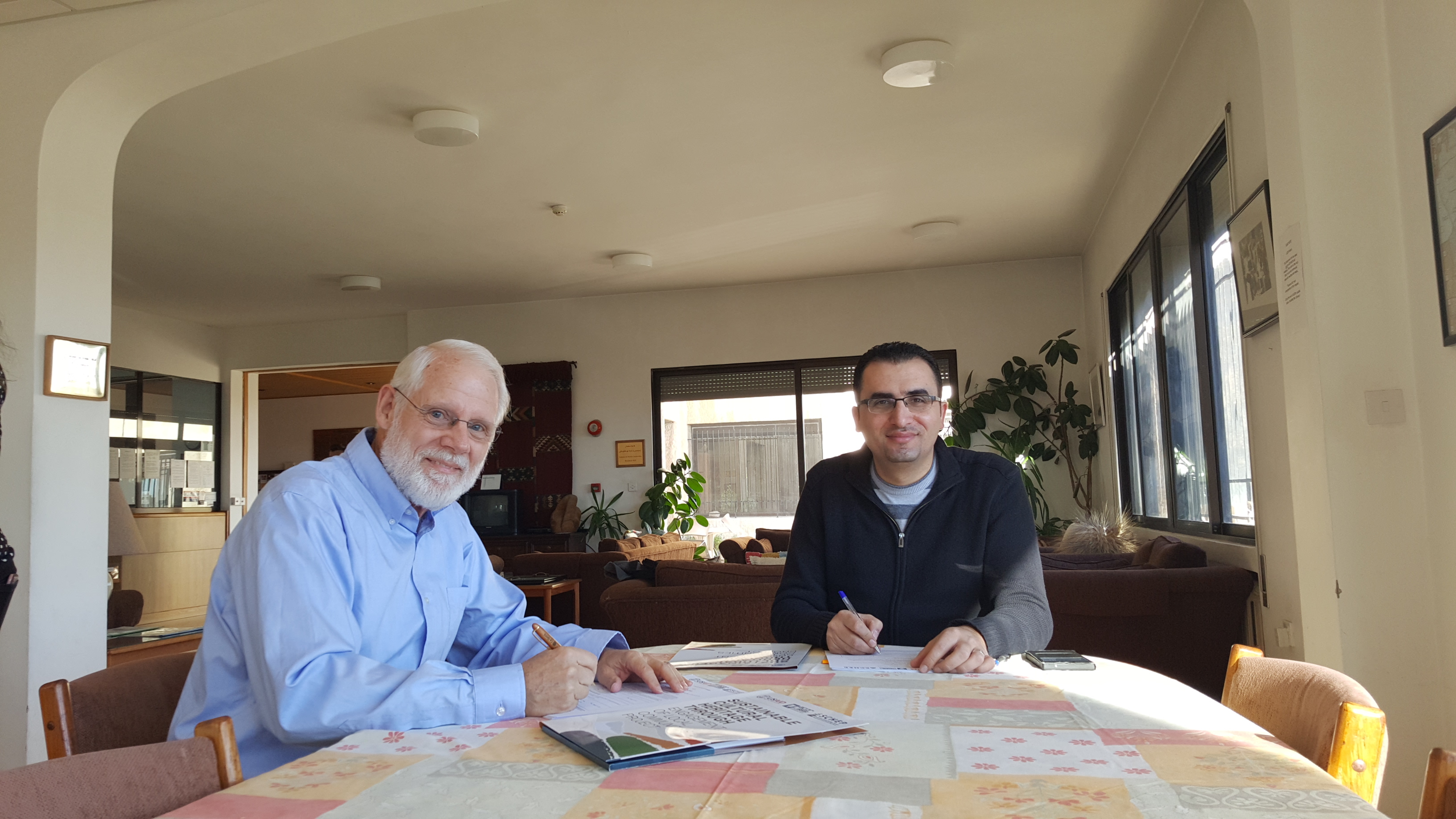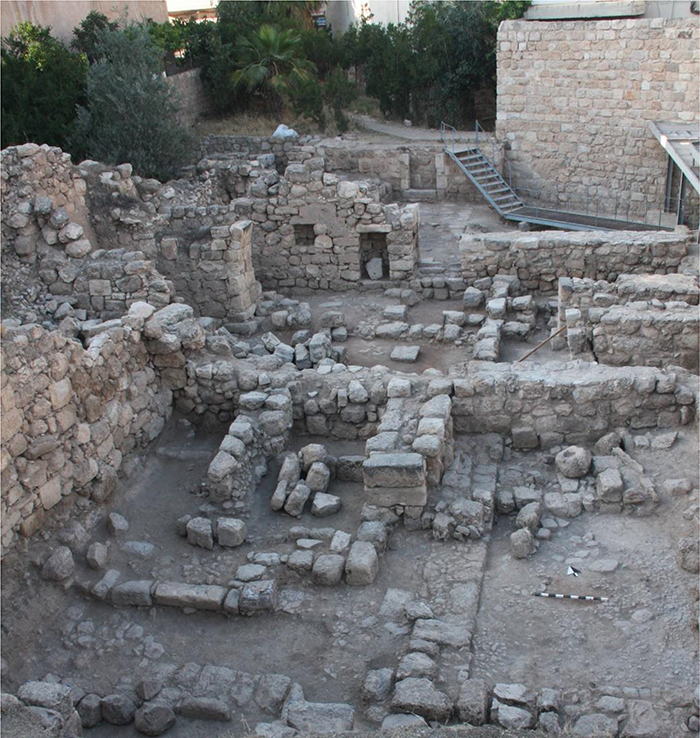
La Sierra University Center for Near Eastern Archaeology Director Doug Clark (left) signs a $117,232 grant to develop a new museum in Madaba, Jordan. Also signing the grant document is Nizar Al Adarbeh, Chief of Party for the Sustainable Cultural Heritage Through Engagement of Local Communities Project, or SCHEP, a USAID program.
Photo by Barbara Porter, director of ACOR
On Jan. 10, 2017, in the offices of an international archaeology organization in Jordan, La Sierra University’s Center for Near Eastern Archaeology Director Doug Clark penned his signature on a grant that will launch development of a long-planned, state-of-the-art museum in the ancient Jordanian town of Madaba.
Clark will lead a multi-national team of archaeologists and antiquities officials from the United States, Italy, and Jordan to further preserve Jordan’s rich, cultural past with the creation of the Madaba Regional Archaeological Museum and at the Madaba Archaeological Park West. The new structure will be located cross the street from the famous St. George’s Church whose floor is inlaid with a mosaic Holy Land map. The museum will showcase the region’s monuments dating from all time periods, especially the Roman-Ottoman periods between the 2nd and 19th centuries.
The museum will also house exhibits from numerous excavations in the broader region, including those headed by La Sierra University. At least 13 dig sites, including Jalul, Hisban, Ataruz and ‘Umayri where La Sierra archaeologists have worked for decades, have unearthed tens of thousands of artifacts and remains dating through the Iron Age. These artifacts have been stored in an aging museum far removed from the center of town.
The $117,232 grant is provided via the Sustainable Cultural Heritage Through Engagement of Local Communities Project, or SCHEP, which is a program of the U.S. Agency for International Development, or USAID. SCHEP is based out of the American Center for Oriental Research in Amman, Jordan, where the grant document was signed by Clark and SCHEP Chief of Party Nizar Al Adarbeh.
The SCHEP grant will cover costs for activities taking place between January 2017 and March 2018 including clearing and cleaning a series of Ottoman houses dating from the 1880s, removing trees and foliage from the museum site, creating and maintaining a collections database, designing a website and logo, hiring and training staff, and finalizing architectural plans.
Existing museum buildings will be renovated and used for artifact storage and research activities.

Ruins of Ottoman houses in Madaba, Jordan, which will be cleaned and readied for the Madaba Regional Archaeological Museum. Photo by Douglas Clark, MRAMP
“There are several houses which were built by Christians arriving from Karak to the south following a long abandonment of Madaba,” Clark said. “The Ottoman houses will form the ground floor of the new museum, which will be built on pillars above these remains. The upper story, or stories, will house remains from the earlier periods in the Madaba region.” These will include some artifacts from La Sierra’s seasonal excavation at ‘Umayri this past summer which Clark directed.
The new museum project also represents an opportunity for La Sierra students and recent graduates who this May will help complete the clearing of the Ottoman houses and prepare the site for professional restorers and architects.
The museum in Madaba, a city about 18.5 miles southwest of Jordan’s capital city of Amman, resides in archaeological regions well known to Clark and his team. Clark, who holds a degree in Hebrew Bible and Old Testament studies from Vanderbilt University, has been involved in archaeological excavations in Jordan since 1973 when he began as a volunteer at Tall Hisban. In 1984 he joined La Sierra archaeologist Larry Geraty at the Tall al-‘Umayri site.
In 1987 Clark became the consortium director for the Madaba Plains Project, then ‘Umayri co-field director followed by director in 2010. In the early 2000s he was tapped by a former Jordan Department of Antiquities director to help digitize the archives of the existing museum in Madaba and train museum staff. Following that appointment, Clark met several times with a group of archaeologists, artists and scholars, including representatives from Jordan’s DoA and Ministry of Tourism, to hash out ways of better preserving the nation’s extensive history and rich cultural heritage, Clark told The Jordan Times in Amman. The idea for a new, centrally-located museum took shape.
The Madaba region is rich in biblical history. “Madaba is mentioned numerous times in the Old Testament, beginning with the entry of Israel into the region following the Exodus. Sometimes it is listed as part of Moabite territory and sometimes as Ammonite,” Clark said. “It was valued in particular because it commanded and controlled a huge area of agricultural land surrounding it, the Madaba Plains. Everyone wanted a piece of this economically rich pie. The city is often mentioned in conjunction with Heshbon (Hisban), and shows up several times in history and prophetic books in the Old Testament.
Biblical archaeology contributes to the recreation of biblical times and culture, informing our reading of the Bible and providing an essential component of Bible study, if we want to understand and appreciate the Bible in its original context,” said Clark.
SCHEP Chief of Party Adarbeh commented on the significance of the museum to the region. “This project is the first of its kind in terms of establishing a museum through engagement with local communities and stakeholders,” he said. “The museum is of high value for preserving the huge repertoire of artifacts from the Madaba region and will present to visitors the lustrous story and history of Madaba. By connecting with the current tourism trail in the city, the museum will also have a significant socio-economic impact on the community,” he said.
